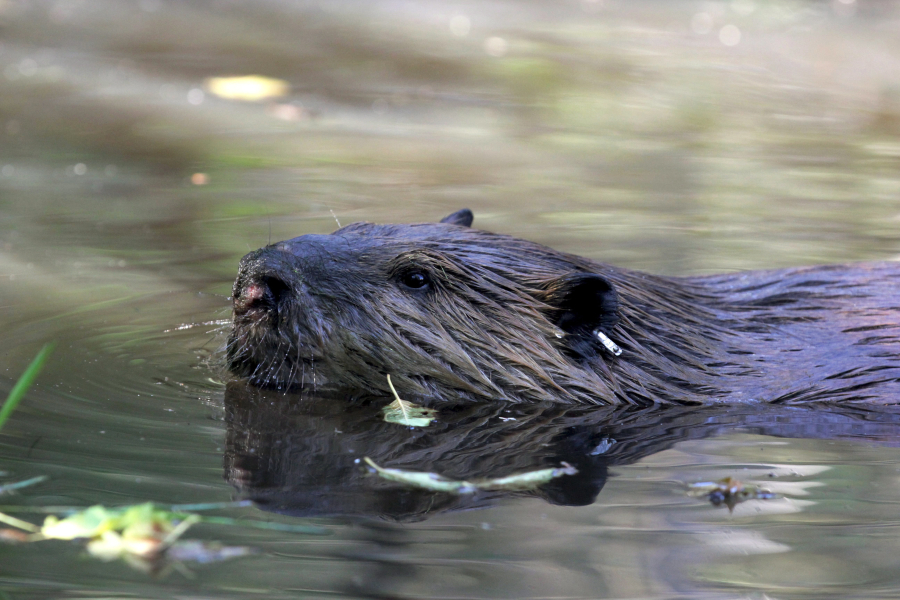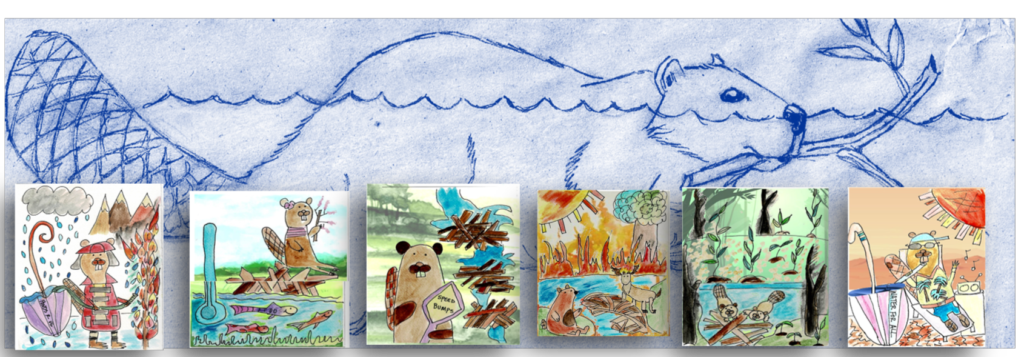Let’s say you lived in a family of all female siblings and your eldest sister was a highly successful model for vogue and came in second at the Olympic ski trials. And then one day you saw her sitting in front of the mirror sobbing because she was so “unattractive no one would ever love her”.
I suppose in those circumstances you might be forgiven for a response that is less than sympathetic.
Which I offer by way of a response to this article which complains:
“But environmental groups say policy makers in Oregon and Washington — where beavers continue to be managed as furbearers, nuisance animals and even predators — have been slow to respond.”
I guess it makes sense that the state who is the best about beaver management in the entire country would also be the state with the least patience for poor or slightly unideal beaver management, but still this article in The Columbian made me snicker ruefully, and mutter over and over again: “tell me about it…”
Why are we still mismanaging beavers in the Northwest?
 Recognition that American beavers are a vital and often missing component of riverine habitats is growing nationwide, especially in the Pacific Northwest.
Recognition that American beavers are a vital and often missing component of riverine habitats is growing nationwide, especially in the Pacific Northwest.
Nearly wiped out across the West a century ago, beavers have spent recent decades regarded as a nuisance animal.
Now, their reputation as a keystone species is slowly taking hold.
The dams they create, for free, offer many of the same benefits as costly rehabilitation projects. Their work has been shown to expand floodplains and wetlands, recharge groundwater, provide higher summer flows, improve water quality, create healthy habitat for salmon and encourage a greater diversity of plants and animals.
The natural water storage they create slows the runoff process, keeps freshwater habitat cooler later into the summer and helps counter the impacts of drought.
And as wildfires become larger and more intense with climate change, beaver ponds have been shown to provide firebreaks and offer refuge for aquatic and land animals.
But environmental groups say policy makers in Oregon and Washington — where beavers continue to be managed as furbearers, nuisance animals and even predators — have been slow to respond.
Oregon—the Beaver State—allows unlimited killing of beavers, and has no mechanisms in place to track how many are taken each year. State agencies have no authority to manage them on private land, and do not know how many beavers there are or where they’re causing problems.
Unlimited killing of beavers? You mean like all those depredation permits that California issues every year that are literally for an UNLIMITED number of beavers? Maybe I’ve been out in the elements for too long to be shocked by these claims, but honestly, show me the state that has a cap on the number of beavers that need to be preserved for a healthy watershed or literally even knows a ball park population number about the amount of beavers they actually have?
In Oregon and Washington, proposals to provide beavers with greater protections are gaining ground.
Washington Department of Fish and Wildlife managers say that making the state’s relocation program permanent could begin as soon as this year. They also point to an opportunity to add beavers as a “species of greater conservation need” in the agency’s statewide wildlife action plan.
In the Oregon Legislature this session, a bill to remove the “predator” status of beavers passed. Beaver supporters say provisions in the bill are small but important measures that can help prevent the indiscriminate killing of beavers and help landowners learn to live with North America’s largest rodent.
Oregon Rep. Pam Marsh, D-Ashland, — the bill’s primary sponsor and chair of the House Committee on Climate, Energy and Environment — says it’s going to take time for beavers in Oregon to be seen as friends instead of foes.
Her bill, she says, is the first step.
Removing its “predator” status will move management of beavers from the Oregon Department of Agriculture to the Oregon Department of Fish and Wildlife, where they can be overseen as wildlife instead of agricultural pests.
Landowners could still kill them on their own property, but most people would need a permit to do so.
After introducing the bill — and before the walkout — Marsh worked with Republicans in her committee and agreed to amended language to gain more support. Under the amended bill, landowners with beavers causing damage that imminently threatens infrastructure or agricultural crops could bypass the permit, and owners of small forestland are exempt.
But everyone would have to report the beavers they kill to the state, giving ODFW an opportunity to estimate out how many beavers are in the state, understand where and how they’re causing problems and provide landowners with options other than killing them.
Honestly, I don’t think we need “protections for beavers”. We need “INCENTIVES FOR LANDOWNERS”. Environmental tax credits for keeping beavers on your property. Funding for installing a flow device. Groups that can help you wrap trees. A live beaver is more valuable than a dead one.
Marsh believes public support for beavers in Oregon is growing.
“We just heard increasing voices across the state for stepping up for beavers,” says Marsh. “We’re seeing beaver-affinity groups, and increasingly seeing landowners who are raving about the results” of allowing beavers to reclaim portions of their property.
Marsh admits beavers can quickly damage property if they’re not properly directed.
“When you know how to work with them, there’s a tremendous capacity to store water and to keep people safe during wildfires,” she says.
And when she evacuated her land in 2020 when the Riverside Fire ranged five miles away, she went to her beaver pond to take a picture of her farm that was threatened by wildfire. She said trees were breaking on her property from the 70 mph winds, and the sky was orange from the nearby blaze.
“In the beaver ponds, it was as if somebody put a glass dome over the ponds,” she said. “It was 10 degrees colder, and it was still. There was no wind. The trees were barely registering, and in that moment, I realized that there’s a lot more happening in these beaver ponds, especially during wildfires, than we’ve even begun to investigate.”
Lovell says the livestock they left behind in the haste of evacuation found refuge there. And the wildland firefighters who used the farm as the entryway to fight the fire identified the ponds as a backup water supply.
“That’s the climate resilience that we really didn’t see and anticipate,” she said.
That is the very best paragraph I’ve ever read about beaver benefits. And I’ve read a lot of them. That should be repeated over and over again until it becomes our national anthem.
The smart article goes on to talk about how farmers are afraid of the restrictions to their land and how beavers can cause problems. Then there’s a a great segment with Jakob Shockey about how beaver problems can be solved.
Jakob Shockey has spent years educating landowners across Oregon about how to coexist with beavers.
Shockey is executive director of the Jacksonville, Ore.-based nonprofit Project Beaver (formerly The Beaver Coalition) and owner of the wildlife control business Beaver State Wildlife Solutions.
“I’ve managed to make a full-time job out of helping the monkeys outsmart the rodents,” Shockey told the House Committee on Climate, Energy and Environment in March.
Shockey told the committee about tools he uses to help growers and other landowners benefit from beavers without the damage that comes with them.
He says pond levelers work like the drain in a bathtub that can be set at any level to prevent the flooding of crops; electric fences have been highly successful at keeping beavers away from orchards; and methods to cage off irrigation culverts prevent them from getting blocked.
“We can come up with some pretty crafty things. Most beaver conflicts you can find a solution for,” says Shockey.
Changing the “predatory” status of beavers would also remove language that labels them as agricultural pests, says Shockey.
“A lot of folks feel like, if they have a pest species on their land, in order to be good stewards of that land they have to get rid of that pest species,” he says, adding that the label sends a signal to landowners that isn’t helpful. “Most folks I end up working with didn’t have any idea that another solution was available.”
Shockey says that landowners who get caught in the endless treadmill of trapping beavers to get rid of them instead of finding a permanent solution to live with them end up impacting neighbors who would benefit from them, too.
“Beavers are territorial, and they mate for life. If you remove one, another family will move in, so you’re going to be depopulating the surrounding region of beavers,” he explains.
Shockey believes the top priority in beaver management should be helping people learn to live with them in the places they choose to repopulate.
“The fact that in the House they were able to work together and get bipartisan support [for HB 3464A], I was just tickled. It feels like the bill we’ve all been hoping for for the last decade.”
Shockey hopes the Oregon Senate can meet and vote on the bill before this year’s legislative session ends.
How much do you love this article? With all your heart or with your intestines too? I guess that’s what happens when the tide starts turning. The places that are already saturated with beaver wisdom start getting more and more soaked and even the dry places like California start to get a little bit smarter.
To Shockey, the public’s perception of beavers changes one landowner at a time. He says even though Oregon is still working to legally change the status of beavers, he thinks the Beaver State is well positioned to lead the Northern Hemisphere in developing a healthier relationship with nature’s greatest engineers.
With help from agencies and Washington organizations, Project Beaver developed a manual for best management practices to help people coexist with them, which people in Europe are looking to adopt, he says.
Once people stop fighting with beavers and start working with them, says Shockey, they’re sold.

Go read the whole beautiful article and send it to all the fence sitters in your life. Great writing K.C. Mehaffey. A few more like this and I could be out of work any day.






































